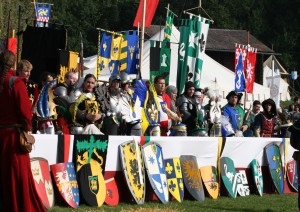Between the twelfth century and seventeenth centuries, Heraldic Standards were a symbolic form of communication both in courts and on the battlefield.
It is no coincidence that the word standard — a raised flag or banner — contains the word “stand.”
It comes to us through Gothic standan (stand) and hardus (hard ) — stand hard, or in modern language, stand firm.
It’s being a banner, a rallying point, a herald, an easy to understand symbol for beliefs where others can plant their standards in order to show allegiance.
 During Feudal times a soldier knew his position on a field according to the standard bearer. He knew where his Lord was by the same signal. He knew his allies and his enemies.
During Feudal times a soldier knew his position on a field according to the standard bearer. He knew where his Lord was by the same signal. He knew his allies and his enemies.
He knew his place, where he should be, simply because he knew what it meant to have a standard.
In the same way, a cook or a page understood his place and duties according to the standard, often sewn into the shirt sleeve or chest of his uniform. He knew that he was a part of a house, that he belonged, that he was an example.
A lord understood that he was the embodiment of that which the standard represented.
If he were a goodly Lord, his servants and those who swore allegiance to him did it out of love.
Today, the use of standards has become all but obsolete.
Yes, nations still have flags, countries have seals, and ships still fly ensigns, but the age of heraldry has become a part of history.
Yet, there is still a need in the modern world for standards, possibly more than ever before.
The need for standards isn’t one of carrying around a flag flying in the wind. It’s the need to be what the standards of the Middle Ages represented.
It’s the need to stand for something so firmly that others know just what that something is.
The banner was not itself anything more than pieces of stitched cloth. What counted, and still counts today, were the actions of those willing to follow that banner.
It was action — the willingness to lead by example and stand in the face of opposition, that motivated the people when they looked upon a standard.
Actions were always the meaning behind the flag. They are what bring people together, and make people willing to support a cause.
It sounds such a simple thing, doesn’t it?
Actions. Good, wholesome actions. Virtuous actions. Edifying actions. Courageous actions.
They are the becons used to muster troops for battle. They are the heralds of arrival. They are the example set forth for others. They define allies and enemies.
And they are today’s standard.
********************
 Eric S. Dowd is earning his education with the help of the Distance Studies program at George Wythe University.
Eric S. Dowd is earning his education with the help of the Distance Studies program at George Wythe University.
He is committed to peace and prosperity achieved through personal beliefs and actions which lead to liberty with respect for the rights of others, responsibility, stewardship of property, liber education, providence with an understanding of mission, and public virtue.
Eric resides with his amazing wife and two amusing dogs in northwest Louisiana.






Speak Your Mind
You must be logged in to post a comment.